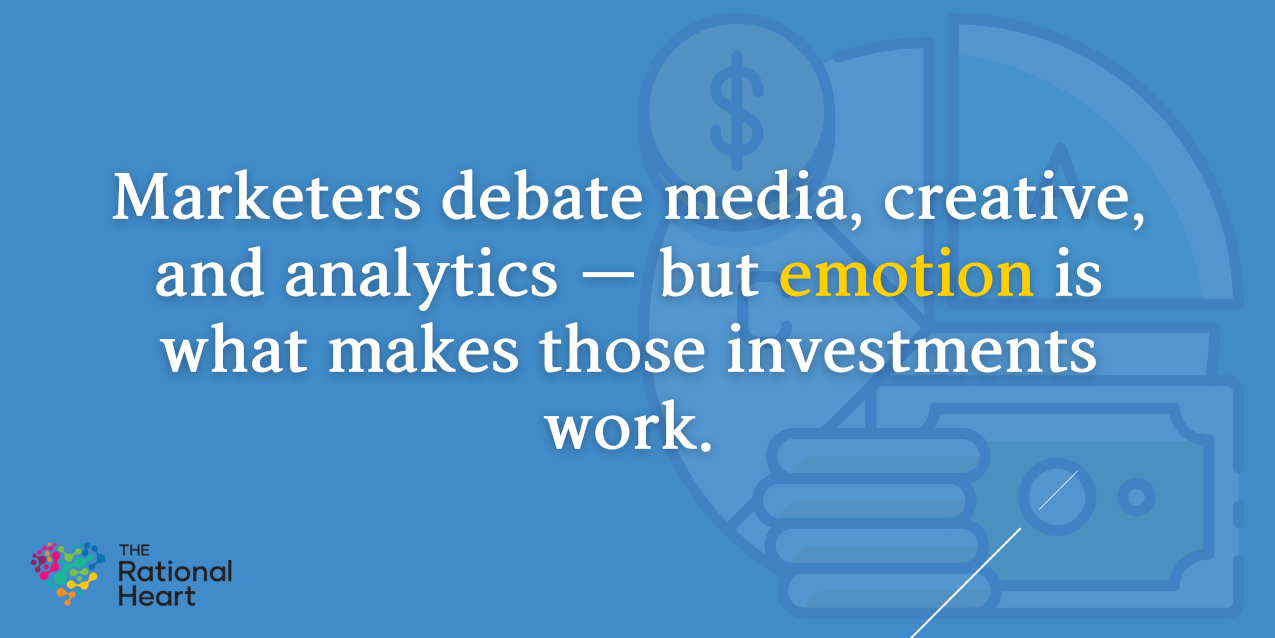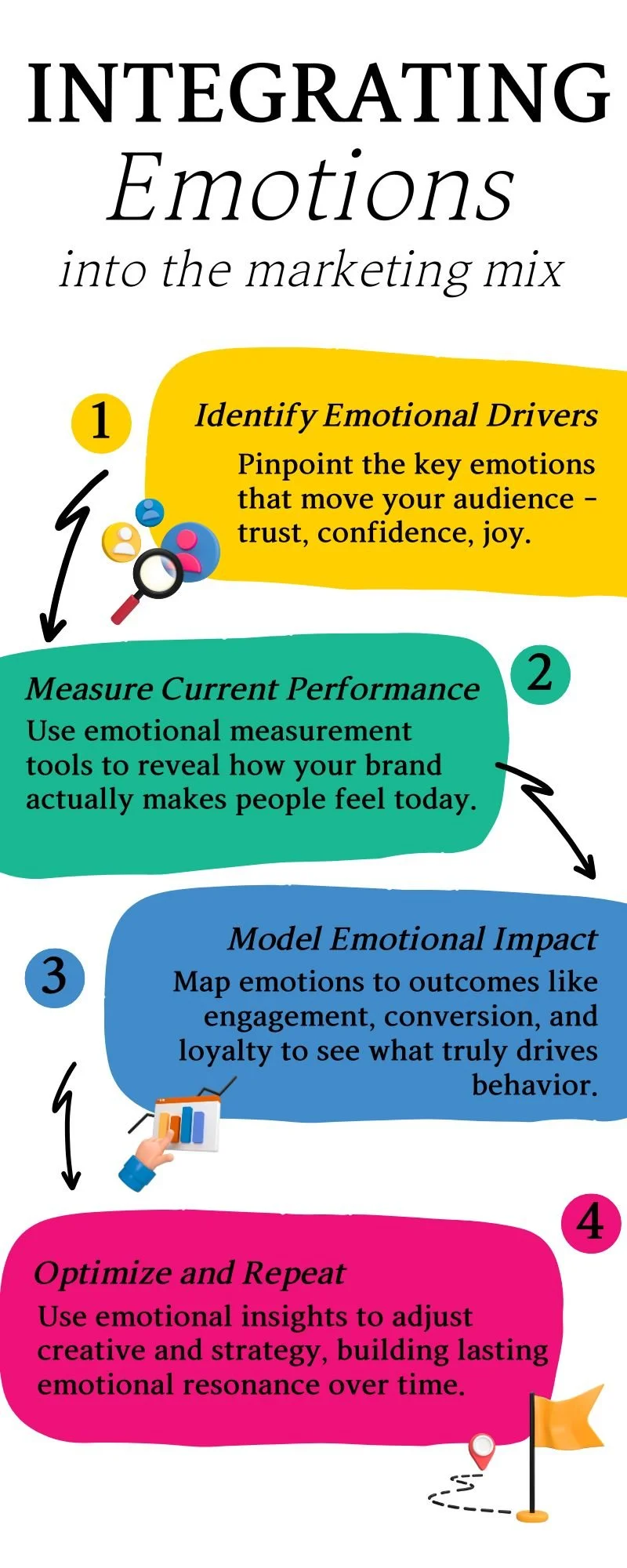Emotions and Marketing: The Missing Multiplier in Your Budget
Most marketers spend time perfecting their budgets—deciding how much to invest in media, creative, or analytics. Yet the true multiplier behind every marketing success isn’t a line item at all: it’s emotion.
When emotion is missing from the marketing budget, the cost shows up in subtle but expensive ways. Campaigns don’t connect, audiences may remember the message but forget the brand, and marketing teams are left wondering why performance looks fine but results feel small.
Behind every metric—every click, share, or sale—there’s a feeling that shaped the outcome. Recognizing and budgeting for that emotional layer turns marketing from a transaction into a relationship.
What’s at Stake When You Leave Emotion Out
Every purchase decision, click, or share is powered by how people feel. Emotions shape attention, guide memory, and determine what people do next.
In our work with brands across industries, we see teams flooded with data about what people do but not why they do it. That’s where emotional measurement changes the game.
When budgets balance rational tactics like media buys and performance tracking with the emotional insights that drive them, every dollar works harder. Emotion transforms information into influence and moves campaigns from simply noticed to truly felt.
Emotion isn’t a “nice to have.” It’s a multiplier. Brands that intentionally invest in emotional strategy unlock stronger performance from the start, maximizing creativity, trust, and pride. Neglecting that balance creates campaigns that look good on paper but fail to move people.
Why Emotions and Marketing Belong in Every Budget
Including emotion in your marketing budget isn’t guesswork. It’s about measuring and modeling emotional response as carefully as you track awareness, conversion, or loyalty.
According to Gallup’s 70/30 Principle, roughly 70% of customer brand preference decisions are driven by emotional factors, while only about 30% are based on rational ones. This reinforces why emotional connection isn’t a “soft” metric—it’s a business driver that shapes loyalty, and long-term value.
Emotionally connected consumers are more loyal, more likely to recommend, and less price-sensitive. They don’t just buy once; they stay.
When brands invest in emotional insight, they move beyond descriptive data that explains what happened. They gain predictive understanding that helps them anticipate what will move people next. Emotional intelligence gives marketers an early advantage, helping them identify emerging needs, adjust tone before fatigue sets in, and create campaigns that feel personal even at scale.
By giving emotion a defined place in the budget, you’re not guessing at connection; you’re engineering it. The best marketers don’t just track clicks. They track feelings. That’s where true differentiation begins.
How to Plan (and Budget) for Emotion
The smartest time to account for emotion is during annual planning, when you decide where your insights and testing dollars will go.
Rather than treating emotional research as an optional add-on, make it part of your core strategy. Here’s how:
Dedicate a portion of your insights budget to emotional measurement. Even five to ten percent can yield meaningful learning.
Include emotion-based KPIs in creative testing and campaign evaluations. Measure how people feel before you measure what they do.
Benchmark emotional performance alongside your brand health metrics so you can track connection over time.
These aren’t extra costs—they’re strategic investments that make every other dollar work harder. When you understand how emotions and marketing interact, your creative decisions get sharper, your storytelling more authentic, and your outcomes more predictable.
Emotion-informed planning also aligns teams internally. When everyone—from creative to analytics—understands the emotional goal of a campaign, execution becomes more consistent and messaging feels more human, no matter the channel or audience.
A Simple Roadmap for Getting Started
If you’re ready to bring emotion into your marketing strategy, start small but start intentionally:
Identify emotional drivers. Determine which emotions matter most in your category. For healthcare, it might be trust and hope. For financial services, confidence and security. For lifestyle brands, joy and belonging. Measure and find out what’s important for your brand.
Measure current performance. Evaluate how your brand and campaigns make people feel right now. Emotional measurement tools, like The Rational Heart’s proprietary methodology, translate those feelings into actionable data.
Model emotional impact. Connect emotional responses to business outcomes such as engagement, conversion, and loyalty.
Optimize and repeat. Use emotional insights to refine messaging, creative tone, and audience targeting.
Once emotion becomes part of your budget, you stop reacting to data and start predicting what will resonate and why. Measuring emotions and marketing together creates a continuous feedback loop that fuels smarter strategy.
The Real ROI of Emotion
Adding emotional intelligence to your marketing isn’t about being sentimental. It’s about being effective.
People process emotion faster than rational information. When your message connects emotionally, it bypasses skepticism and activates memory. That’s why emotion-rich campaigns drive higher recall and stronger brand preference.
Emotionally intelligent marketing also builds resilience. When audiences feel something genuine, they’re more forgiving of missteps and more likely to stay through change. It’s not just about sparking excitement—it’s about earning trust and loyalty that last.
Think of emotion as the ultimate efficiency tool. It shortens the distance between message and meaning. The stronger the feeling, the faster the response. By designing for emotion, you design for speed, relevance, and impact.
In the long run, emotions and marketing alignment becomes your competitive edge—measurable, repeatable, and scalable. The brands that budget for it see the difference in both hearts and numbers.
The Bottom Line
Every marketing budget reflects priorities. When emotion isn’t one of them, you’re investing in logic alone—and logic doesn’t inspire loyalty.
The most effective marketers balance rational strategy with emotional insight. They know emotion isn’t the opposite of reason—it’s what makes reason matter.
At The Rational Heart, we help brands quantify emotion so every marketing dollar performs with both heart and precision. We’d love to help you plan for it. Reach out today, and let’s talk about what the right emotional research investment could look like for your brand next year.


